Cooking ribeye steak perfectly has never been easier. The secret really comes down to one technique that does not involve expensive equipment.
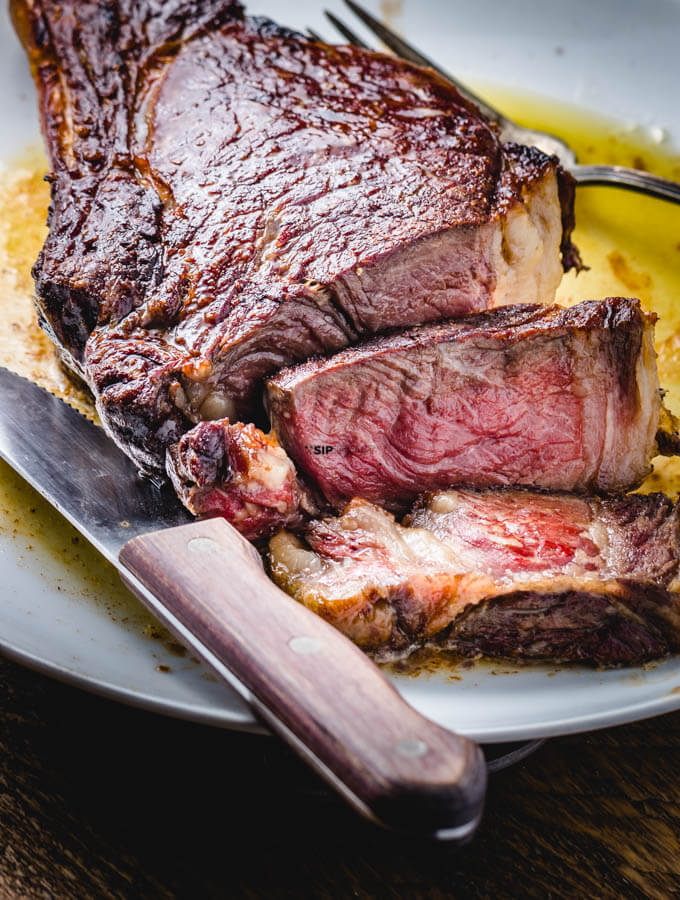
The “reverse sear method” – it’s a foolproof way to get a perfectly cooked steak every single time.
Before you get started on your killer steak make this Classic martini with blue cheese olives – It goes so well with a thick steak!
Easy ribeye steaks
Normally in a steakhouse, the meat is cooked either on an open grill or a snake broiler which can top 1800 degrees.
The snake broiler method employed by Peter Luger’s and many other high-end steakhouses, does a combination of the two.
They will grill it outright, place it in a broiler-safe dish and snake broil it for a couple of minutes. The charred top is super delicious and smells amazing.
If you have never been to Luger’s I suggest making a reservation when you are in New York.
So thanks James for telling me about how awesome Peter Luger’s is, but can you get to how I make a perfect steak?
Simple – cheating with a reverse sear method. In this way, we can get a perfectly cooked steak.
The steak will still have an awesome seared crust and will never be overcooked.
Cooking ribeye steak the more “traditional way”, requires a little more finesse. Can it be done? Sure – but I like easy.
Cooking a steak with the reverse sear method is foolproof.
With an instant-read thermometer, the steak is cooked exactly to within 10-15 degrees of final doneness. Finish it up with 1 minute of searing per side and it is perfect every time.
I love a steak medium-rare, but my son likes it towards the medium-well side so I try to accommodate him as best I can.
Cooking ribeye steaks like this is simple because I can take each steak to the right temperature before the reverse searing process.
Want To Save This Recipe?
Have some people coming over and each likes a different doneness? No problem – you get the idea!
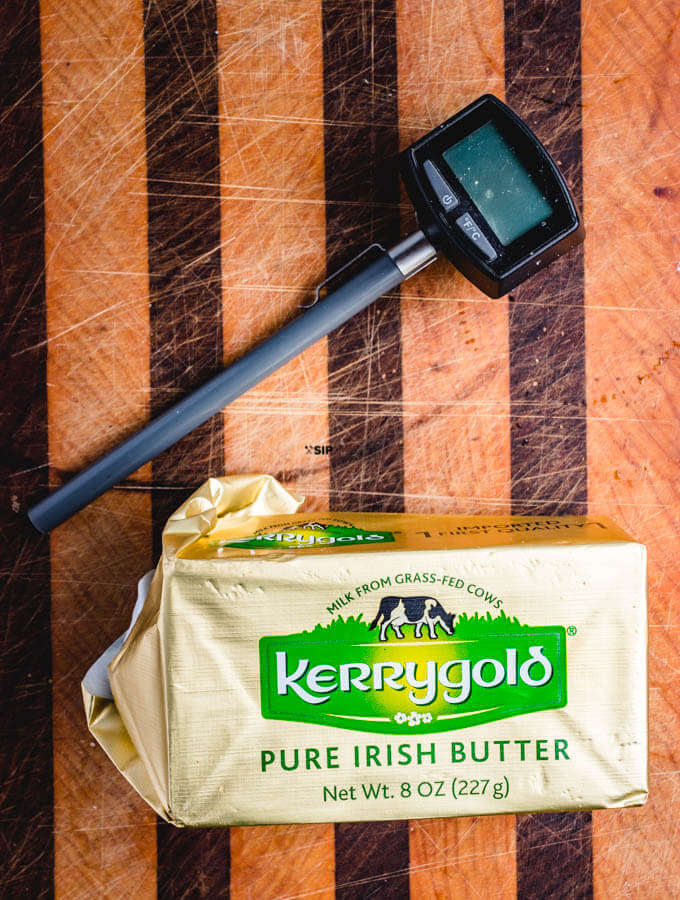
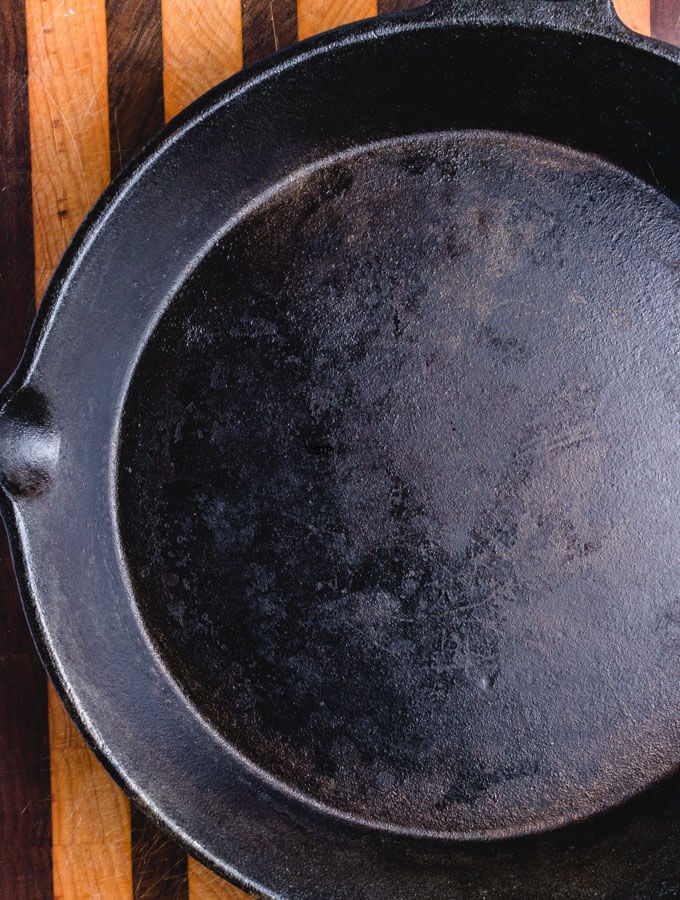
Steaks, ribeyes, and quality
There are 4 types of meat that are often available in supermarkets and specialty stores:
- Select grade – Will look really red and have no marbling at all.
- Choice grade – Has more marbling than select but is still better for marinating or heavy spice rubs.
- Prime grade – This is the quality that is most often served in high-end steakhouses. It has excellent marbling and tastes awesome with just salt.
- Kobe and Wagyu – The best and highest marbled beef. It has a very unique look, and a very high price tag to go along with it. The American Wagyu Association has all the good info if you crave this very special beef.
Quality steaks are really important when not marinating or heavily seasoning.
Why? Because it’s all about the flavor of the steak. Nothing is hiding or masking the flavor.
With just butter, salt, and pepper for this recipe I suggest splurging for prime grade beef. It will never let you down.
To get quality beef at a fair price, Costco should always be a first consideration.
Whole Foods prices have gotten a lot better with the Amazon takeover as well. Just remember, prime grade beef will always be much higher priced than choice grade.
Need to do a bunch of steaks? I have still made a perfect steak with their choice cuts. You may need to spend a few more minutes picking through the choice beef. Sometimes I have found great marbled choice cuts, probably due to an error at the store or a grading mistake.
Reverse sear method
To me, nothing does a better job cooking ribeye steak than the reverse sear method. Ribeyes have the perfect amount of fat content.
That fat means juicy, delicious flavor! The marbling of the fat gives it an unbelievable taste – a taste that simply can’t be found in a filet.
I definitely enjoy other cuts of beef too. A porterhouse would be excellent as well – if that’s your favorite, go buy some good ones. This recipe will work exactly the same. A New York strip would also be a solid choice.
I don’t recommend this technique with a skirt steak, flank, or other thinner cuts. I would just cook them straight on the grill.
I love those cuts, especially skirt steak, but for this recipe get a thick steak, preferably a 2″ thick ribeye!
More steak info
- How to cook any big steak in a pan? Cook it as hot as possible to get the absolute best sear. The sear is such a crucial part of the ultimate steak experience. Cast Iron works especially well at charring the steak. If you don’t have a cast iron, a heavy steel pan would work as well. I have cooked great reverse seared steaks that way too. Just take your time getting the pan screaming hot. The cast iron can definitely take the beating – just remember to open the windows.
- What type of oil to cook steaks in? High smoking point oils are the way to go. I use vegetable oil to get a great sear- I do not recommend olive oil as it will burn too easily and working at a super high heat is paramount. The butter goes in at the end of the steak searing process so that is not a big burning concern.
- Is well done steak bad? This is a touchy one. I truly believe you got to eat what you like. If you are interested in some convincing check out 5 reasons to never order steak well done. I could extol the virtues of a medium-rare steak all day, but ultimately it’s your money and your taste buds! Moving on…
- Tips on cooking steak: Reverse sear is just a perfect way to take the guess work out of cooking a big meal. Timing a hot steak is simple with this method. A steak can be cooked through in the oven and covered with foil for hours before beginning the searing process. This works out real well when some other dishes are being prepared. The steak is always ready to go. It can even be wrapped and put in the fridge overnight. If doing this make sure to get the steak out early to get it up to room temperature!
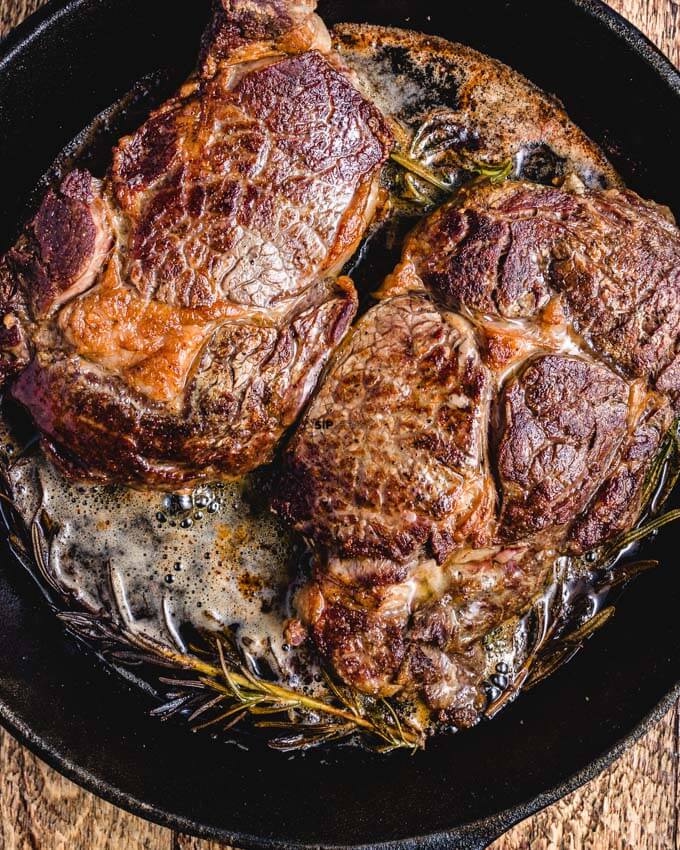
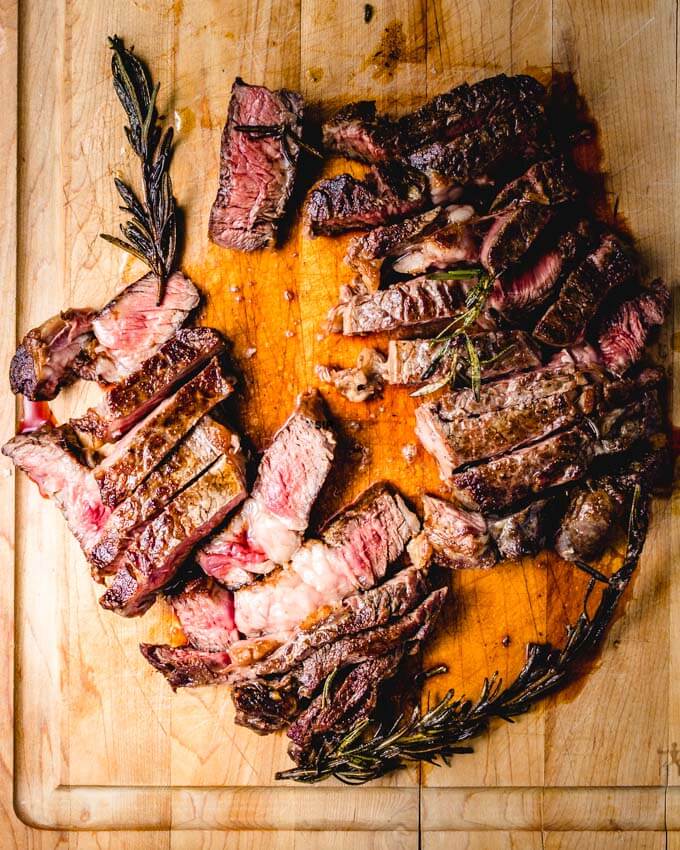
Reverse Searing Process:
- Remove steaks from the refrigerator about 1 hour before cooking.
- Preheat oven to 250°F – the lower the better but the meat will take longer.
- Season ribeyes on a wire rack and baking tray setup. Add about 1/2-1 tsp of salt and 1/8 tsp of pepper per steak.
- Place steaks in the oven and cook for about 1 hour for 2 inch thick steaks. Start checking the temperature of steaks with an instant-read thermometer at the 45-minute mark.
- Remove steaks at 115°F for medium-rare. Medium-rare is 130°F-135°F. The steaks will be seared to this temperature so make sure to remove them from the oven at no higher than 115°F-120°F if medium-rare is desired.
- Let steaks rest for 15 minutes, lightly covered before searing them.
- Preheat cast iron or heavy steel skillet on your hottest burner to super hot levels. Give it a few minutes to get really hot. Open a window and/or turn on an exhaust vent.
- Sear steaks for 1 minute on each side in 1-2 Tbsp of vegetable oil.
- Add 2 Tbsp of butter during the last 30 seconds of searing.
- Remove steaks and pour butter mixture over top and serve immediately.
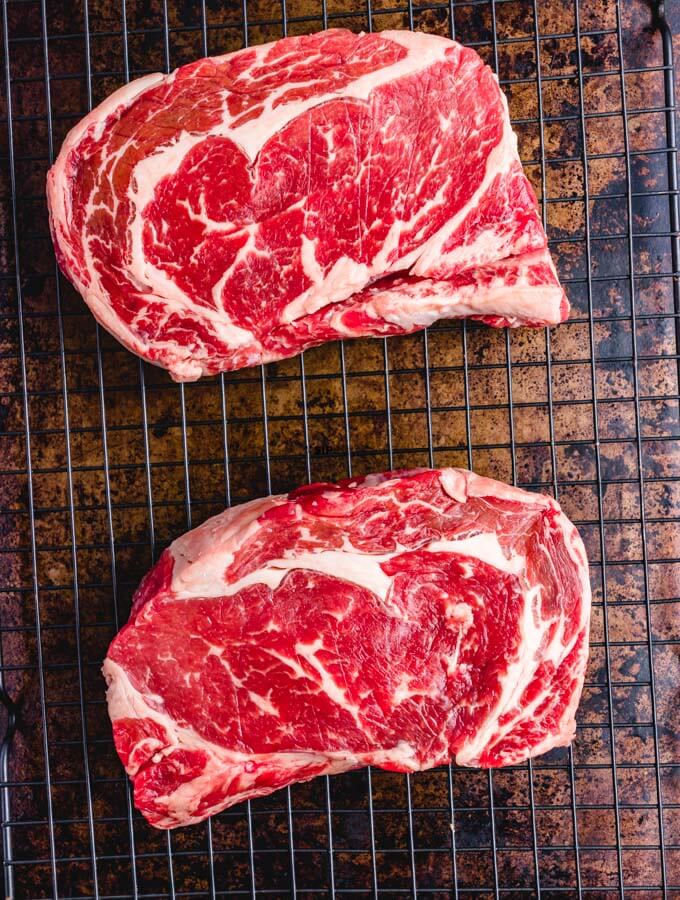
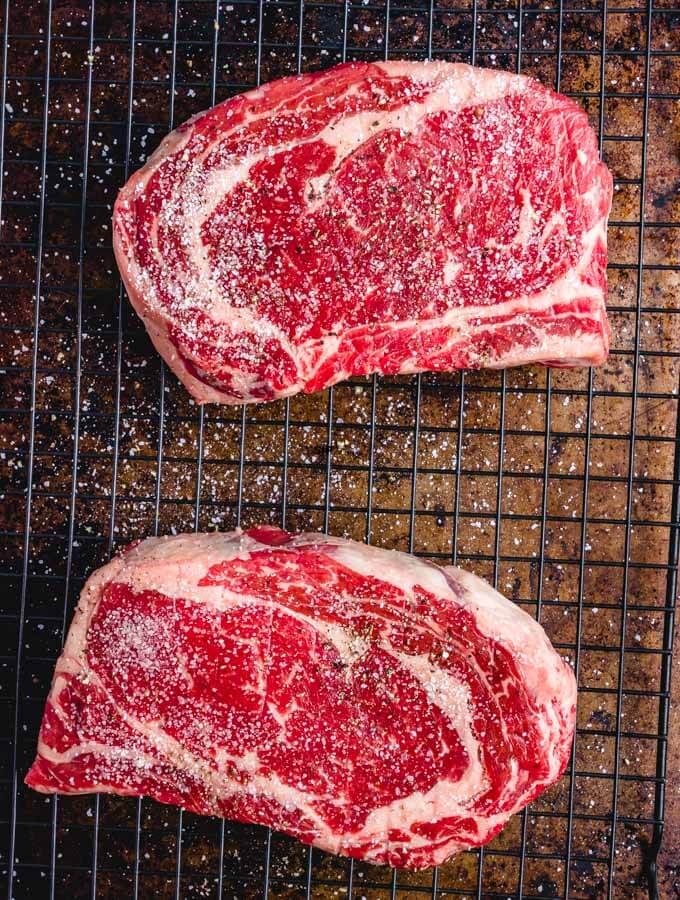
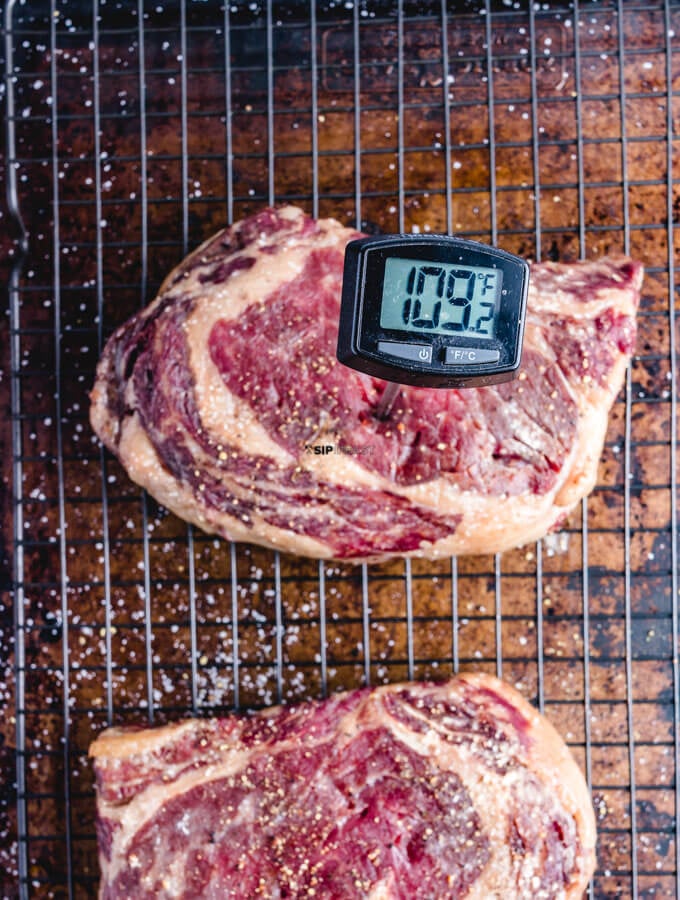
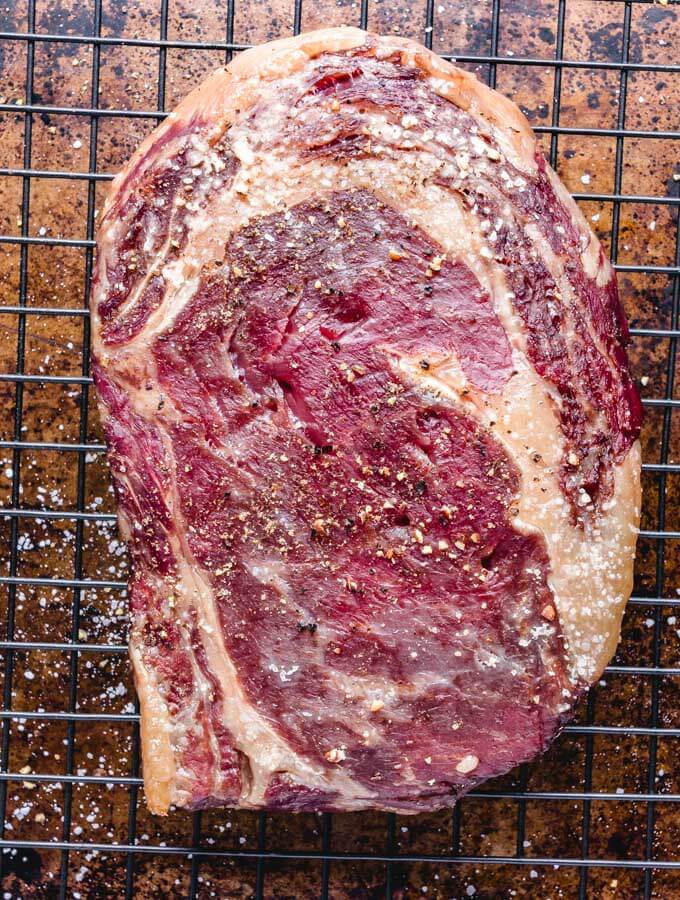
Perfect Steak Temperature:
| Doneness | Temp to remove from oven | Final temp after searing |
| medium – rare | 115f | 130f – 135f |
| medium | 125f | 140f – 145f |
| medium – well | 135f | 150f – 155f |
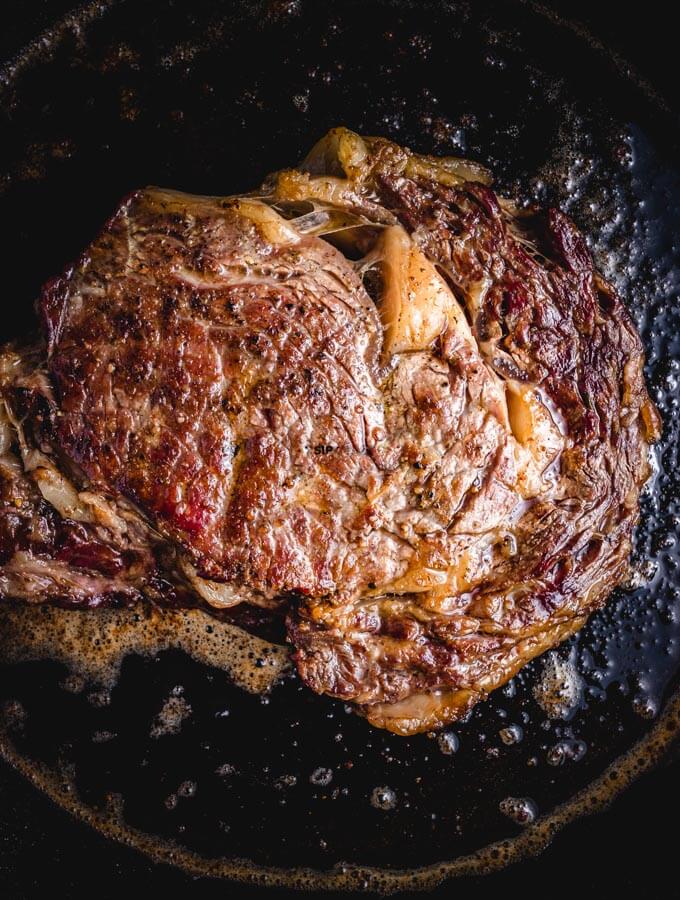
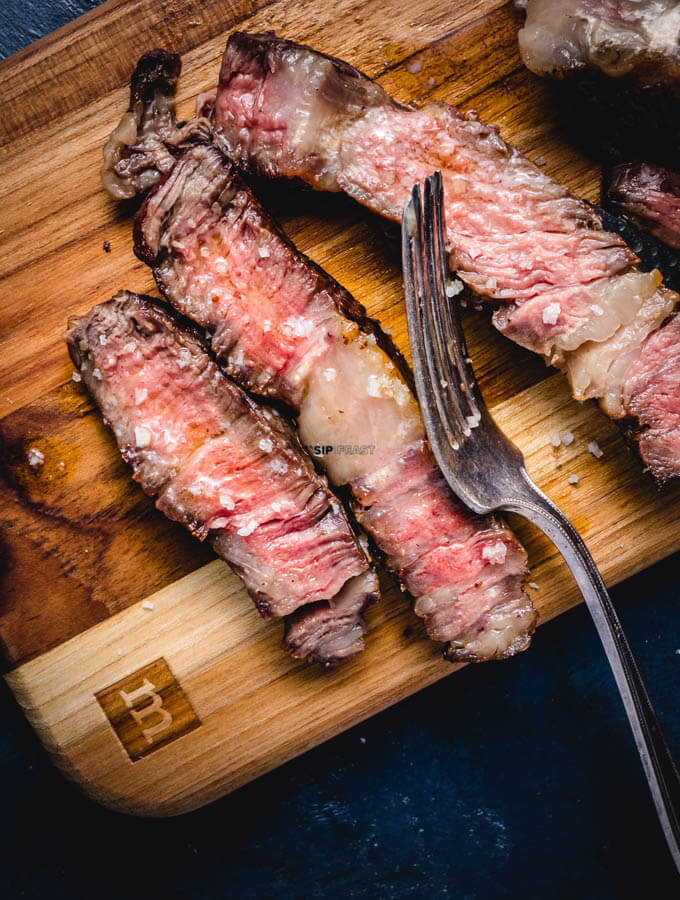
Great side dishes
- Maple roasted carrots – Easy glazed carrots with butter and maple syrup.
- Roasted garlic mashed potatoes – Fluffy and creamy garlic-infused potatoes.
- Broccoli with garlic and oil – Simple side dish with sauteed broccoli in garlic, olive oil, and a touch of red pepper flakes.
- Creamed spinach – shallots, spinach, roux, cream, and a touch of nutmeg.
- Balsamic butter mushrooms – Seared mushrooms finished with balsamic vinegar and butter.
If you’ve enjoyed this reverse-seared ribeye steak recipe or any recipe on this site, give it a 5-star rating and tell us about it in the comments below.
We would love to hear how you did and it’s nice to show others as well. Thanks!
Follow us on YouTube, Instagram, Pinterest, and Facebook.
Cooking Ribeye Steak 101 - Reverse Sear Method
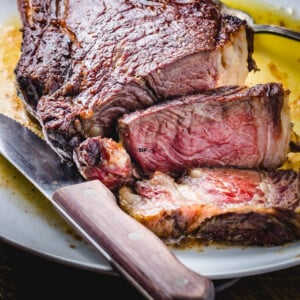
Ingredients
- 2 large ribeye steaks - 1.5"-2" thick steaks.
- 1-2 Tbsp vegetable oil
- 2 Tbsp butter
- 1-2 tsp kosher salt
- 1/4 tsp black pepper
Want To Save This Recipe?
Instructions
- Remove steaks from fridge 1 hour before cooking.
- Preheat oven to 250f - the lower the better but the meat will take longer. Do not go over 275f.
- Season Ribeyes on wire rack and baking tray setup. Lay foil under wire rack for an easier cleanup. Pat steaks dry then add about 1/2-1 tsp of salt and 1/8 tsp of pepper per steak. Salt generously! Remember the steaks are thick.
- Place steaks in oven and cook for about 1 hour for 2 inch thick steaks. Time will vary based on size of steak. Start checking temperature of steaks with an instant read thermometer at 45 minute mark.
- Remove steaks from oven at 115f for medium-rare. Medium-rare is 130f-135f. The steaks will be seared to this temperature so make sure to remove from oven at no higher than 115f-120f if medium-rare is desired.
- Let steaks rest for 15 minutes before searing.
- Preheat cast iron or heavy steel skillet on hottest burner to as hot as it will get. Give it a couple minutes to get super hot. Open a window and/or turn on exhaust vent because the searing process will create a lot of smoke.
- Sear steaks for 1 minute on each side in 1-2 Tbsp of vegetable oil.
- Add 2 Tbsp of butter during last 30 seconds of searing.
- Remove steaks and pour butter mixture over top and serve immediately.
Notes
Nutrition
Nutrition information is automatically calculated, so should only be used as an approximation.
Follow Me
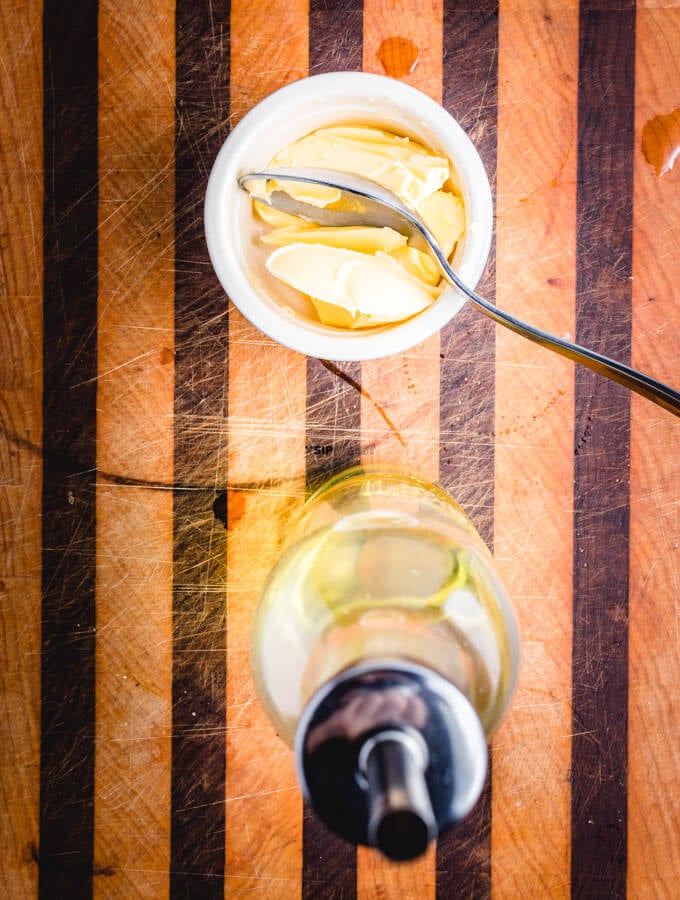







You keep saying poor on butter mixture after the searing, but you never say what the butter mixture is. What is in it?
So I just did garlic
Hi BJ, 2 tablespoons of butter gets added during the last 30 seconds of searing. The butter “mixture” is the butter plus any drippings in the pan from the steak.
Jim, love this method, it came out perfectly. My question, wondering if I do for guests, timing isn’t always as controlled with everyone snacking, talking, drinking…. Have you even let the steak sit longer after removing from oven, over an hour maybe then sear to serve when everyone was ready? Thank you for your input on this.
Hi Den. The main issue is that the interior might be a bit cool. You could cook the steaks a bit less initially so that they have a bit more time to sear and heat up the interior. Either way it will definitely work and produce good results. Enjoy!
Wow, did this method ever result in a juicy, tender, delicious steak! 1-3/4″ thick, 20 oz. ribeye. After patting dry I used coarse salt and pressed it into the meat. After 45 minutes at 250, the internal temp was already at 120F (could be a signal that my oven runs a little hot?). After letting it rest 15 minutes, I seared the edges, especially hard on the fat side, and both sides. Because of the 15-minute rest, I don’t think the steak’s internal temperature went too far beyond 120F. The outside was seared magic and the inside was beautiful, red, warm, and juicy. This is the best ribeye I’ve ever cooked, better than anything I’ve done on the grill or in the frying pan. Great method, will use whenever possible! Cheers!
We’re so happy you enjoyed!
When you put the steak in the oven to cook it at 250°, do you put it in or do you just put it in the oven with nothing on it except the seasoning.
Hi Spike, can you clarify what you’re asking when you say “put it in”?
I treated myself to a nice Delmonico steak from the local butcher. Followed this recipe exactly and it was by far the best steak ever! Thank you for sharing.
Hi Zandra, we’re so happy you enjoyed the steak!
I love Ribeye steaks cooked this way, thank you for your help to make it better.
Hi Luz, thanks for the comment and so happy you enjoyed the recipe!
So, I tried this. In your notes, you said you could do oven then refrigerate until next day but another asked you if you could and you said not recommended and should you bring to room temp first?? Which is it cuz I am doing it this right now with a $23 ribeye and would hate to throw it out or get sick.
Hi Denise, I believe the commenter was asking about cooking the steaks fully, refrigerating, then doing a sear to warm them back up. What you can do is cook in the oven to ~15 degrees less than the desired final temp after searing, cover with foil, and refrigerate. Then, remove the steak from the fridge at least 1 hour before starting the searing process.
Jim,
Thanks so much for your input! Keep up the great work!
Pam
My pleasure, Pam! Thank you!
Jim, love all your recipes! You do a great job!
I recently purchased 4 ribeye steaks from Lidl’s which are from steakhouse naturals. They are 100 % grass fed Angus beef and they are 10 oz each no bone at about 1″ thick. How would I adapt this recipe for steaks that are not as thick as the 1 1/2- 2 ” ones?
Thanks!
Hi Pam, thank you and happy you’re enjoying the recipes! Everything would be the same but you’ll cook for less time considering they’re half the thickness of the ones in the recipe. If you want to get a really good sear, you may want to consider cooking in the oven to a lower internal temperature than I suggested, that way you can sear for the full 1 minute per side. So for example, if you want medium-rare, remove from the oven when the steak reaches 105f.
Hi James, would this work on a BBQ too. I have friends over next week and am thinking this would be an easy option to precook it and rest it earlier in the day and then simply sear it on the bbq when we are ready to eat… Or do you think it would over cook if cooked too early?
Absolutely! We cook steaks on the grill with the reverse sear method all the time. You can do the oven step even the day before and place the almost cooked steaks in the fridge. Just cook them 15 degrees less than your final temp and you will be set!
If I were to precook and refrigerate steaks would I have to sear longer to come to temp? Should I bring steaks back to room temp before searing?
Hi Ali. I wouldn’t really recommend this. The issue is that the steak would have a cold center and seared outside since a quick sear wouldn’t be able to properly reheat the interior. By the time the center gets hot, the steak would most likely be overcooked. Hope this helps.
This looks like a very good low tech way to produce a wonderful steak. Is there is any reason one could carry out the same idea with a sous vide apparatus (if available)?
Thank you! You absolutely can do the exact same thing with a sous vide machine. I don’t have one, but I hear it works perfectly that way too.
Tried this recipe last night and I have to say this was the BEST steak I have had in a very long time, I think I like the reverse searing better than the recipe I had before where you sear it first then bake it. But to top it off I made some of the homemade Cowboy Butter and put a dab on each one while finishing up and it was to die to for. Thanks so much for sharing this recipe.
Thanks very much! So glad you enjoyed it!
Looks so dang Tasty! Looooove me some good steak.
Thanks Ben! Yes, it’s very hard to beat a good steak.